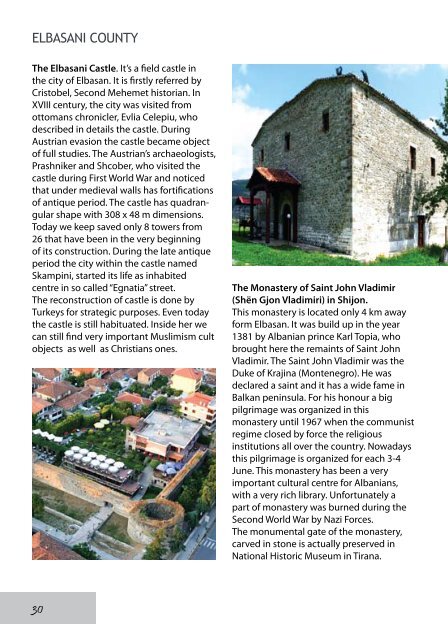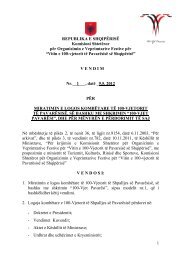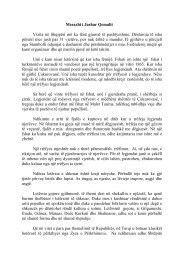Albanian Cultural Heritage
Albanian Cultural Heritage
Albanian Cultural Heritage
You also want an ePaper? Increase the reach of your titles
YUMPU automatically turns print PDFs into web optimized ePapers that Google loves.
ELBASANI COUNTY<br />
The Elbasani Castle. It’s a field castle in<br />
the city of Elbasan. It is firstly referred by<br />
Cristobel, Second Mehemet historian. In<br />
XVIII century, the city was visited from<br />
ottomans chronicler, Evlia Celepiu, who<br />
described in details the castle. During<br />
Austrian evasion the castle became object<br />
of full studies. The Austrian’s archaeologists,<br />
Prashniker and Shcober, who visited the<br />
castle during First World War and noticed<br />
that under medieval walls has fortifications<br />
of antique period. The castle has quadrangular<br />
shape with 308 x 48 m dimensions.<br />
Today we keep saved only 8 towers from<br />
26 that have been in the very beginning<br />
of its construction. During the late antique<br />
period the city within the castle named<br />
Skampini, started its life as inhabited<br />
centre in so called “Egnatia” street.<br />
The reconstruction of castle is done by<br />
Turkeys for strategic purposes. Even today<br />
the castle is still habituated. Inside her we<br />
can still find very important Muslimism cult<br />
objects as well as Christians ones.<br />
30<br />
The Monastery of Saint John Vladimir<br />
(Shën Gjon Vladimiri) in Shijon.<br />
This monastery is located only 4 km away<br />
form Elbasan. It was build up in the year<br />
1381 by <strong>Albanian</strong> prince Karl Topia, who<br />
brought here the remaints of Saint John<br />
Vladimir. The Saint John Vladimir was the<br />
Duke of Krajina (Montenegro). He was<br />
declared a saint and it has a wide fame in<br />
Balkan peninsula. For his honour a big<br />
pilgrimage was organized in this<br />
monastery until 1967 when the communist<br />
regime closed by force the religious<br />
institutions all over the country. Nowadays<br />
this pilgrimage is organized for each 3-4<br />
June. This monastery has been a very<br />
important cultural centre for <strong>Albanian</strong>s,<br />
with a very rich library. Unfortunately a<br />
part of monastery was burned during the<br />
Second World War by Nazi Forces.<br />
The monumental gate of the monastery,<br />
carved in stone is actually preserved in<br />
National Historic Museum in Tirana.








